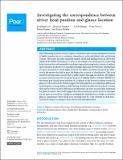| dc.contributor.author | Victor, Trent | |
| dc.contributor.author | Lee, Joonbum | |
| dc.contributor.author | Muñoz, Mauricio | |
| dc.contributor.author | Fridman, Alex | |
| dc.contributor.author | Reimer, Bryan | |
| dc.contributor.author | Mehler, Bruce | |
| dc.date.accessioned | 2018-10-18T13:33:24Z | |
| dc.date.available | 2018-10-18T13:33:24Z | |
| dc.date.issued | 2018-02 | |
| dc.date.submitted | 2016-08 | |
| dc.identifier.issn | 2376-5992 | |
| dc.identifier.uri | http://hdl.handle.net/1721.1/118598 | |
| dc.description.abstract | The relationship between a driver's glance orientation and corresponding head rotation is highly complex due to its nonlinear dependence on the individual, task, and driving context. This paper presents expanded analytic detail and findings from an effort that explored the ability of head pose to serve as an estimator for driver gaze by connecting head rotation data with manually coded gaze region data using both a statistical analysis approach and a predictive (i.e., machine learning) approach. For the latter, classification accuracy increased as visual angles between two glance locations increased. In other words, the greater the shift in gaze, the higher the accuracy of classification. This is an intuitive but important concept that we make explicit through our analysis. The highest accuracy achieved was 83% using the method of Hidden Markov Models (HMM) for the binary gaze classification problem of (a) glances to the forward roadway versus (b) glances to the center stack. Results suggest that although there are individual differences in head-glance correspondence while driving, classifier models based on head-rotation data may be robust to these differences and therefore can serve as reasonable estimators for glance location. The results suggest that driver head pose can be used as a surrogate for eye gaze in several key conditions including the identification of high-eccentricity glances. Inexpensive driver head pose tracking may be a key element in detection systems developed to mitigate driver distraction and inattention. Keywords: Head movements, Glance classification, Head-glance correspondence, Driver distraction | en_US |
| dc.description.sponsorship | New England University Transportation Center | en_US |
| dc.description.sponsorship | Santos Family Foundation | en_US |
| dc.description.sponsorship | Toyota Motor Corporation (Class Action Settlement Safety Research and Education Program) | en_US |
| dc.publisher | PeerJ Inc. | en_US |
| dc.relation.isversionof | http://dx.doi.org/10.7717/peerj-cs.146 | en_US |
| dc.rights | Creative Commons Attribution 4.0 International License | en_US |
| dc.rights.uri | http://creativecommons.org/licenses/by/4.0/ | en_US |
| dc.source | PeerJ | en_US |
| dc.title | Investigating the correspondence between driver head position and glance location | en_US |
| dc.type | Article | en_US |
| dc.identifier.citation | Lee, Joonbum, et al. “Investigating the Correspondence between Driver Head Position and Glance Location.” PeerJ Computer Science, vol. 4, Feb. 2018, p. e146. © 2018 Lee et al. | en_US |
| dc.contributor.department | Massachusetts Institute of Technology. Center for Transportation & Logistics | en_US |
| dc.contributor.mitauthor | Lee, Joonbum | |
| dc.contributor.mitauthor | Muñoz, Mauricio | |
| dc.contributor.mitauthor | Fridman, Alex | |
| dc.contributor.mitauthor | Reimer, Bryan | |
| dc.contributor.mitauthor | Mehler, Bruce | |
| dc.relation.journal | PeerJ Computer Science | en_US |
| dc.eprint.version | Final published version | en_US |
| dc.type.uri | http://purl.org/eprint/type/JournalArticle | en_US |
| eprint.status | http://purl.org/eprint/status/PeerReviewed | en_US |
| dc.date.updated | 2018-10-11T18:20:12Z | |
| dspace.orderedauthors | Lee, Joonbum; Muñoz, Mauricio; Fridman, Lex; Victor, Trent; Reimer, Bryan; Mehler, Bruce | en_US |
| dspace.embargo.terms | N | en_US |
| dc.identifier.orcid | https://orcid.org/0000-0002-4790-0108 | |
| dc.identifier.orcid | https://orcid.org/0000-0003-1484-6843 | |
| dc.identifier.orcid | https://orcid.org/0000-0003-4850-8738 | |
| dc.identifier.orcid | https://orcid.org/0000-0001-5929-4179 | |
| mit.license | PUBLISHER_CC | en_US |
